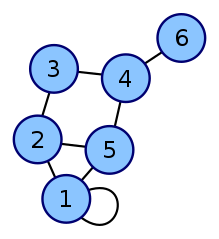In the mathematical field of graph theory, the degree matrix is a diagonal matrix which contains information about the degree of each vertex—that is, the number of edges attached to each vertex.[1] It is used together with the adjacency matrix to construct the Laplacian matrix of a graph.[2]
Definition
Given a graph G G=(V,E) with |V|=n, the degree matrix D for G is a \( n\times n \) diagonal matrix defined as[1]
\( {\displaystyle D_{i,j}:=\left\{{\begin{matrix}\deg(v_{i})&{\mbox{if}}\ i =j\\0&{\mbox{otherwise}}\end{matrix}}\right.} \)
where the degree \( \deg(v_{i}) \) of a vertex counts the number of times an edge terminates at that vertex. In an undirected graph, this means that each loop increases the degree of a vertex by two. In a directed graph, the term degree may refer either to indegree (the number of incoming edges at each vertex) or outdegree (the number of outgoing edges at each vertex).
Example
Vertex labeled graph

Degree matrix
\({\begin{pmatrix}4&0&0&0&0&0\\0&3&0&0&0&0 \\0&0&2&0&0&0\\0&0&0&3&0&0\\0&0&0&0&3&0\\0&0&0&0&0&1\\\end{pmatrix}} \)
Properties
The degree matrix of a k-regular graph has a constant diagonal of k.
References
Chung, Fan; Lu, Linyuan; Vu, Van (2003), "Spectra of random graphs with given expected degrees", Proceedings of the National Academy of Sciences of the United States of America, 100 (11): 6313–6318, doi:10.1073/pnas.0937490100, MR 1982145, PMC 164443, PMID 12743375.
Mohar, Bojan (2004), "Graph Laplacians", in Beineke, Lowell W.; Wilson, Robin J. (eds.), Topics in algebraic graph theory, Encyclopedia of Mathematics and its Applications, 102, Cambridge University Press, Cambridge, pp. 113–136, ISBN 0-521-80197-4, MR 2125091.
Undergraduate Texts in Mathematics
Graduate Studies in Mathematics
Hellenica World - Scientific Library
Retrieved from "http://en.wikipedia.org/"
All text is available under the terms of the GNU Free Documentation License

